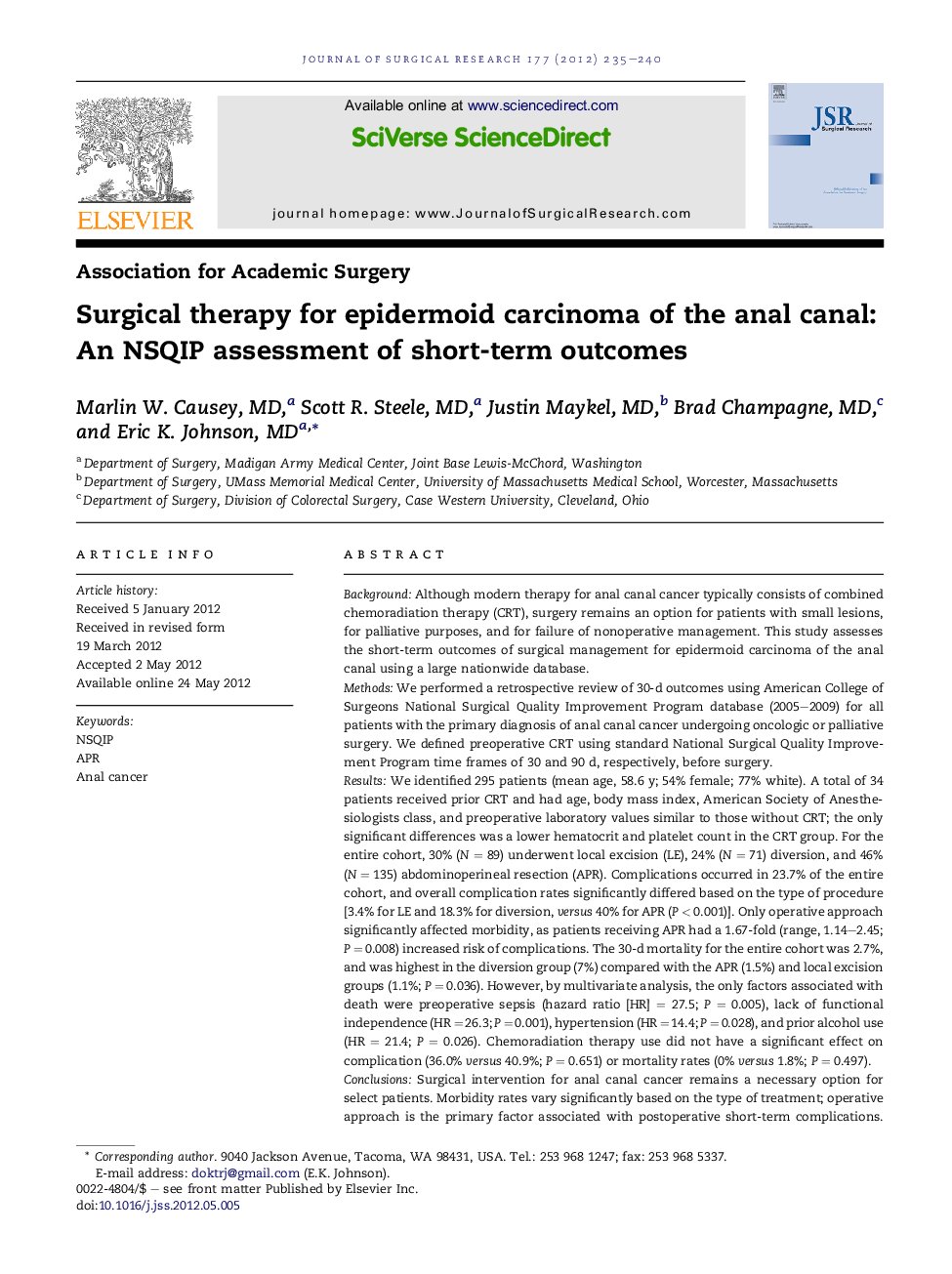| کد مقاله | کد نشریه | سال انتشار | مقاله انگلیسی | نسخه تمام متن |
|---|---|---|---|---|
| 4301210 | 1288434 | 2012 | 6 صفحه PDF | دانلود رایگان |

BackgroundAlthough modern therapy for anal canal cancer typically consists of combined chemoradiation therapy (CRT), surgery remains an option for patients with small lesions, for palliative purposes, and for failure of nonoperative management. This study assesses the short-term outcomes of surgical management for epidermoid carcinoma of the anal canal using a large nationwide database.MethodsWe performed a retrospective review of 30-d outcomes using American College of Surgeons National Surgical Quality Improvement Program database (2005–2009) for all patients with the primary diagnosis of anal canal cancer undergoing oncologic or palliative surgery. We defined preoperative CRT using standard National Surgical Quality Improvement Program time frames of 30 and 90 d, respectively, before surgery.ResultsWe identified 295 patients (mean age, 58.6 y; 54% female; 77% white). A total of 34 patients received prior CRT and had age, body mass index, American Society of Anesthesiologists class, and preoperative laboratory values similar to those without CRT; the only significant differences was a lower hematocrit and platelet count in the CRT group. For the entire cohort, 30% (N = 89) underwent local excision (LE), 24% (N = 71) diversion, and 46% (N = 135) abdominoperineal resection (APR). Complications occurred in 23.7% of the entire cohort, and overall complication rates significantly differed based on the type of procedure [3.4% for LE and 18.3% for diversion, versus 40% for APR (P < 0.001)]. Only operative approach significantly affected morbidity, as patients receiving APR had a 1.67-fold (range, 1.14–2.45; P = 0.008) increased risk of complications. The 30-d mortality for the entire cohort was 2.7%, and was highest in the diversion group (7%) compared with the APR (1.5%) and local excision groups (1.1%; P = 0.036). However, by multivariate analysis, the only factors associated with death were preoperative sepsis (hazard ratio [HR] = 27.5; P = 0.005), lack of functional independence (HR = 26.3; P = 0.001), hypertension (HR = 14.4; P = 0.028), and prior alcohol use (HR = 21.4; P = 0.026). Chemoradiation therapy use did not have a significant effect on complication (36.0% versus 40.9%; P = 0.651) or mortality rates (0% versus 1.8%; P = 0.497).ConclusionsSurgical intervention for anal canal cancer remains a necessary option for select patients. Morbidity rates vary significantly based on the type of treatment; operative approach is the primary factor associated with postoperative short-term complications. When surgery is required, recent CRT is not associated with a higher complication rate. With proper perioperative care and surgical technique, mortality rates remain low, and the increased death rate with diversion, even in the short term, likely represents advanced disease.
Journal: Journal of Surgical Research - Volume 177, Issue 2, October 2012, Pages 235–240